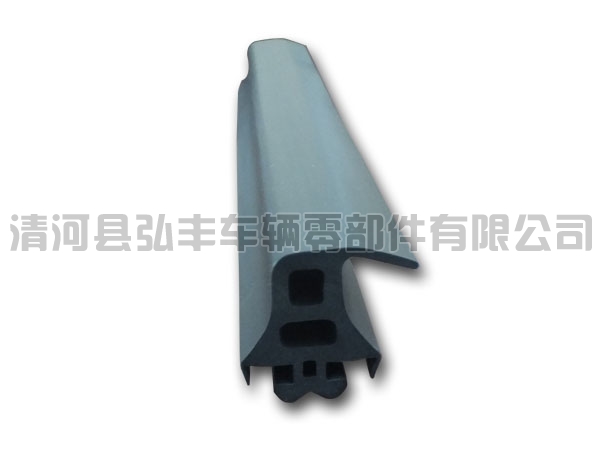Automobile sealing strip is one of the important parts of automobile. It is widely used in door, window, body, seat, skylight, engine case and trunk. It can produce rubber hinge for installing passenger car luggage compartment door. It also plays an important role in waterproof, sealing, sound insulation, dust prevention, antifreeze, shock absorption, heat preservation and energy saving. It must have strong tensile strength, good elasticity, and good temperature resistance and aging resistance. In order to ensure the fastening of the adhesive strip and the profile, the cross-sectional structure size of the adhesive strip must match the profile.

According to different materials, it can be roughly divided into the following categories:
1. Vulcanized rubber sealant strip
It is generally made of EPDM. Excellent comprehensive performance, outstanding ozone resistance, excellent weather resistance, good high and low temperature resistance, outstanding chemical resistance, resistance to a variety of polar solutes and low relative density. The disadvantage is that it has large expansion in general mineral oil and lubricating oil, and it is generally dark products. Operating temperature range - 60 ~ 150 ℃. With its wide application range and excellent comprehensive performance, it has been recognized by industry enterprises at home and abroad.
2. Silicone rubber sealant strip
It has outstanding high and low temperature resistance, ozone resistance and weather resistance; Excellent hydrophobicity and proper air permeability; With unparalleled insulation performance; It can reach the hygienic level of food hygiene requirements and meet the requirements of various colors. The disadvantage is that the mechanical strength is the worst among rubber materials and is not oil resistant. Operating temperature range: - 100 ~ 300 ℃. It can be used in areas with high temperature, cold and strong ultraviolet radiation, as well as medium and high-rise buildings.
3. Neoprene sealant strip (CR)
Compared with other special rubbers, individual properties are worse, but the overall performance balance is good. It has excellent weather resistance, ozone resistance, heat aging resistance, oil and solvent resistance, good chemical resistance, excellent flame resistance and good adhesion. Poor storage stability, hardening phenomenon will occur during storage, and poor cold resistance. The relative density is large. Generally black products. It is used in the environment with requirements of oil resistance, heat resistance, acid and alkali resistance. Operating temperature range - 30 ~ 120 ℃.
4. Nitrile rubber sealing strip
It is mainly characterized by oil resistance and solvent resistance, but not resistant to ketones, esters, chlorinated hydrocarbons and other media. It has good elastic and mechanical properties. The disadvantage is that it is easy to age and crack in ozone and oxidation, and has poor cold resistance and low temperature resistance.
5. Thermoplastic elastomer sealant strip
It has good elasticity, excellent wear resistance, good oil resistance, wide adjustable hardness range (shore a hardness 65 ~ 80 degrees), superior mechanical properties (tensile strength and elongation at break), excellent cold resistance and chemical corrosion resistance, and high price of raw materials. It is a recyclable material. Operating temperature range - 60 ~ 80 ℃. It is applicable to earthquake prone areas, areas with strong vibration near railways or plants with high-power cranes, and areas with strong ultraviolet radiation.
6. Thermoplastic vulcanizate (TPV) sealant strip
With the flexibility and elasticity of rubber, it can be produced by plastic processing method without vulcanization, and the waste can be recycled and reused. It is a material with a wide range of properties, with good heat resistance and cold resistance, low relative density, similar oil resistance and solvent resistance to neoprene, and poor compression permanent deformation resistance and wear resistance. Operating temperature range - 40 ℃ ~ 150 ℃. It can be applied to cold, medium and high-rise buildings.
7. Plasticized polyvinyl chloride (PPVC) sealant strip
The material is cheap and easy to obtain, with corrosion resistance, wear resistance, acid and alkali resistance and various chemical media, combustion resistance and high mechanical strength; The disadvantage is that the plasticizer in the coordination system is easy to migrate, hardens and becomes brittle with the extension of time, loses elasticity, is not resistant to aging, and has poor weather resistance and low temperature performance. Generally dark products. It is suitable for occasions where the light is not strong, the temperature changes little and the weather conditions are not bad.
8. Surface coating material
The surface of the sealing strip is coated with polyurethane, silicone, polytetrafluoroethylene and other substances to replace the surface flocking of the traditional process. The coated sealing strip has good wear resistance and smoothness. In particular, the sealing strip coated with silicone surface coating has a small surface friction coefficient, which is conducive to the sliding of door and window leaves. Applicable to doors and windows with sliding doors and window sashes. It is a substitute for traditional silicified top.
 CONTACT US
sale hotline
13313392399
CONTACT US
sale hotline
13313392399